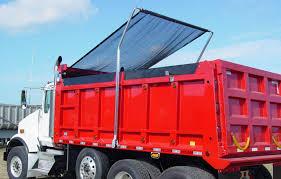Dump Truck Tarp Systems: Installation, Maintenance & Safety Tips

Dump trucks are a necessity for construction, landscaping, and hauling operations, but compliance and safety are closely tied to productivity. Dump truck tarp systems keep materials contained during transit, preventing spills, accidents, and costly fines. Hauling gravel, sand, or debris, selecting the appropriate tarp system, and properly maintaining it can be the difference between safety, efficiency, and dollars saved.
Why Dump Truck Tarp Systems Matter
A tarp system is not just a cover; it's a compliance device, a safety feature, and a business asset. Federal and state regulations often require loads to be secured to prevent material from spilling out. Besides regulatory needs, tarps safeguard your freight from the weather and keep your crew and other drivers safe on the road.
A quality dump truck tarp system can:
-
Increase the life of your equipment.
-
Reduce downtime caused by maintenance issues.
-
Improve compliance with DOT and state regulations
-
Increase efficiency with faster covering and uncovering.
Types of Dump Truck Tarp Systems
Before installing a system, it's essential to know your options. The main types include:
-
Manual Tarp Systems: Affordable and reliable, but require physical effort. Best for small fleets or occasional use.
-
Electric Tarp Systems: Push-button operation, saving time and labor. Suitable for large fleets and high-volume haulers.
-
Hydraulic Tarp Systems: Strong and designed for heavy-duty jobs, with the best durability for industries requiring efficiency.
The selection of the system will be based on the size of your truck, the type of load, and your budget.
Installation Tips for Dump Truck Tarp Systems
Installing a dump truck tarp system correctly ensures smooth operation and longevity. While professional installation is always recommended, here are some best practices if you're handling it in-house:
- Measure Accurately: Start with precise measurements of your dump body to ensure a snug, effective fit.
-
Use Proper Mounting Hardware: Always use the manufacturer's recommended brackets, arms, and fasteners.
-
Check Alignment: Poor alignment can cause uneven wear or jamming.
-
Electrical Installation: In electrical systems, ensure that wiring is fastened and out of the way of moving components.
Investing a little time to install properly will pay off in reduced future repairs and downtime.
Tips for Regular Maintenance to Ensure a Smooth-Stream System
Even the most outstanding tarp system requires regular maintenance. Maintenance is an investment that prolongs the useful life of an asset and prevents expensive breakdowns.
- Regular Inspections: Check for frayed seams, tiny tears, or loose hardware. Repair minor problems before they become major ones.
-
Lubricate Moving Components: Ensure arms, rollers, and pivot points are lubricated according to the manufacturer's recommendations.
-
Clean After Use: Dirt, debris, and moisture can cause tarps to break down over time. Clean and dry your tarp thoroughly after heavy use.
-
Replace Worn Components Early: Small items, such as springs or cables, can compromise the entire system if left unattended.
By focusing on maintenance, you help your tarp system remain dependable season after season.
Safety Tips for Using Dump Truck Tarp Systems
Safety should always be the top priority when operating heavy equipment. When using a dump truck tarp system:
-
Never operate the system while standing on the truck bed.
-
Avoid overloading your dump body, which puts extra strain on the tarp.
-
Ensure your tarp is fully deployed before moving.
-
Train all operators on safe handling and proper use.
Adhering to these safety measures not only decreases accidents but also ensures compliance with state and federal regulations.
Getting Quality Tarps for Trucks
When selecting tarps for trucks, opt for materials that are durable and can withstand heavy usage. Materials such as vinyl-coated polyester, mesh tarps, and heavy-duty canvas offer both strength and weather resistance. Custom sizes are also available from many suppliers to match your own truck size.
Look for providers who offer not only high-quality tarps but also replacement parts and installation support. Reliable suppliers ensure you're never left without a functioning system.
Conclusion
A dump truck tarp system is more than a regulatory requirement; it's an investment in safety, efficiency, and your bottom line. From choosing the correct type of system to maintaining it regularly, every step matters in maximizing performance. By following proper installation, upkeep, and safety practices, you'll keep your trucks compliant, your crews safe, and your projects running smoothly.
If you're considering upgrading or replacing your system, explore trusted providers offering tarps for trucks that match your specific needs. The right tarp system protects not just your cargo, but also your business.





